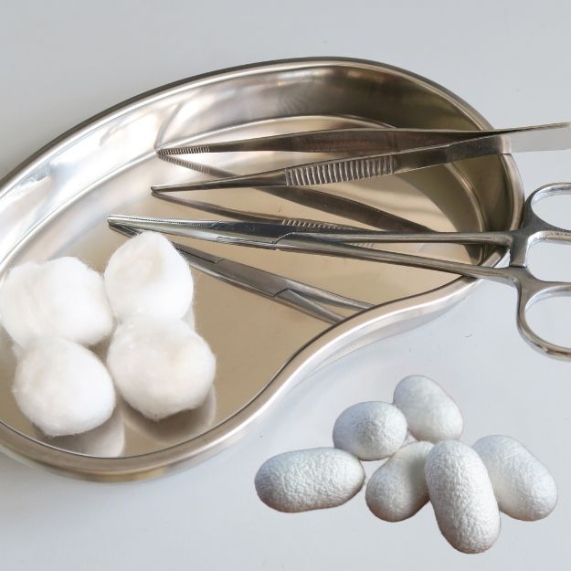Wound management currently represents a growing concern for healthcare systems. Non-healing chronic wounds, particularly common in diabetic patients, can lead to serious consequences, including amputations and deaths. The wound healing process is complex and involves numerous interactions between cells, secretion factors, and extracellular matrices (ECM) across different phases: exudative, reabsorbable, proliferative, and regenerative. Despite advances in regenerative medicine, there remains an urgent need to develop more effective biomaterials for wound care. It is in this context that silk fibroin is emerging as a promising solution.
Silk fibroin, the biological jewel
The silkworm cocoon is a biological composite material with a hierarchical structure composed of silk fibers in a sericin matrix. During metamorphosis from larva to moth, the Bombyx mori silkworm produces and spins a large amount of silk using specific glands. Ecologists believe this structure has evolved over millions of years to optimize protection of silkworm pupae from animal and bacterial attacks and adverse environmental conditions. Silk fibroin (SF) is a protein derived from the domestic Bombyx mori that has demonstrated interesting characteristics for textile applications, drug delivery, imaging, and tissue engineering. It is also a material approved by the Food and Drug Administration (FDA) for certain biomedical applications.
Unique properties for wound healing
The mechanical properties of silk fibroin are primarily associated with interactions within its building blocks. Fibroin is mainly composed of hydrophobic β-sheet crystallites and hydrophilic amorphous domains. The crystallite domains are composed of heavy and light chain polypeptides, predominantly containing the amino acids glycine (Gly) and alanine (Ala); hydrogen bonds provide an anti-parallel β-sheet arrangement maintaining adjacent chains.
This natural multi-domain protein has demonstrated superior elasticity and biocompatibility, combined with versatile biodegradability and excellent processability. Its thermal stability, which reaches about 250°C, makes it particularly resistant. Furthermore, it is distinguished by its structural robustness with greater resilience against changes in temperature, humidity, and pH compared to other biopolymers, characteristics that make it ideal for biomedical applications in variable physiological environments.
Applications in wound healing
In the form of hydrogel, sponge, film, or electrospun nanofiber, silk fibroin has demonstrated excellent properties as a biomaterial for dressings. Its ability to maintain a moist environment and ensure gas permeability creates optimal conditions for healing. At the same time, it significantly promotes cell growth, proliferation, and migration of various cell lines involved in the various phases of the wound healing process, accelerating the body's natural repair mechanisms. Fibroin matrices accelerate cell adhesion, wound contraction, re-epithelialization, angiogenesis, and collagen formation. In in vitro and in vivo studies on wound healing, SF-based biomaterials have demonstrated good cell adhesion and fibroblast proliferation, with improved neovascularization, faster healing, and better tissue outcomes.
Experimental evidence
On skin wounds generated on the backs of New Zealand rabbits, silk fibroin sol-gel films have demonstrated better wound healing compared to standard dressings. Histological analysis revealed successful reconstruction of the epidermis. After 10 days of treatment with fibroin biomaterials, wound sizes were reduced to approximately 30%, and further reduced to about 11% after 15 days, while in control samples they were approximately 52% and 49% respectively.
Fibroin also seems to play a role in suppressing the increase of proinflammatory cytokines during the inflammation phase of the wound, with a consequent protective effect on cells and tissues during the healing process. Inactivation of the apoptotic pathway along with stimulated cell migration are other effects attributed to silk fibroin.
The future of silk in medicine
The growing number of publications dedicated to the application of silk fibroin in different fields of tissue engineering demonstrates the increasing interest of scientific research in this biomaterial. To promote functional tissue regeneration, a biomaterial should support and promote biological functions, responding adequately to the specific needs of different tissues - and fibroin is proving to have all the credentials for this purpose.
Nature once again offers us an elegant solution to a complex medical challenge, reminding us that sometimes the most innovative answers are found in the biological structures that surround us.


